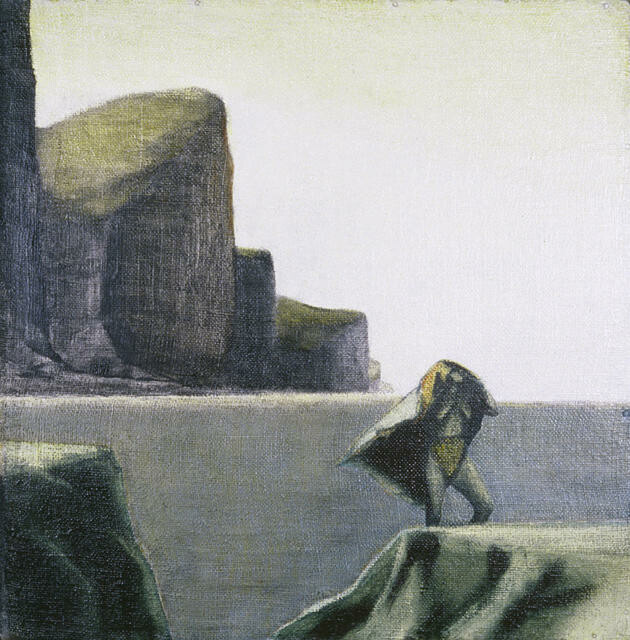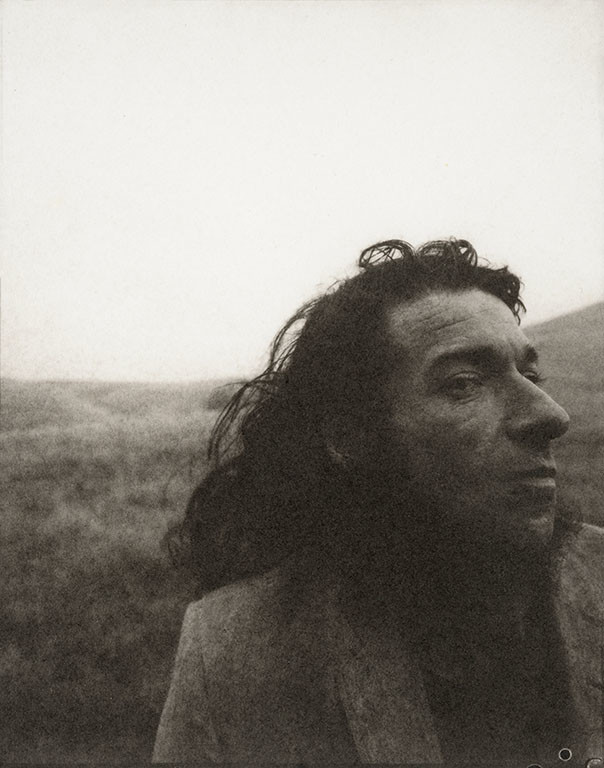Tony Fomison
Aotearoa New Zealand, b.1939, d.1990
Legend Of Murihaka
- 1981-1983
- Oil on hessian
- Purchased 1984
- 920 x 920mm
- 84/12
Tags: horizon line, landscapes (representations), Māori (culture or style), mythology (literary genre), natural landscapes, peninsulas, people (agents), seas, stylization, women (female humans)
In the 1950s Tony Fomison developed a close relationship with a group of Maori living near Lake Wairewa (Forsyth) on the road to Akaroa. Although Legend of Murihaka was painted later, when he was living in Auckland, it is the Banks Peninsula landscape that features in this work.
Legend of Murihaka is typical of Fomison’s intense paintings, which are characteristically dark, with simplified forms and dramatic compositions. On the coarsely-textured canvas Fomison has wiped the paint from the surface, leaving only faint stains of colour to create strong contrasts between light and shade.
Fomison was born in Christchurch. He studied sculpture at the University of Canterbury and later travelled on an Arts Advisory Board grant to England and Europe to study the Old Masters. He moved to Auckland in 1973. There he continued his lifelong interest in Maori and Polynesian cultures, which he often incorporated into his work. In 1985 Fomison was the first recipient of the Rita Angus Fellowship. He exhibited throughout New Zealand.
Exhibition History
Picturing the Peninsula,21 April - 22 July 2007
Tony Fomison depicts the actions of Murihaka, wife of Potahi, who wore the cloak belonging to Ngai Tahu’s upoko ariki (paramount chief) Te Maiharanui at Waikakahi near Birdlings Flat / Puranui around 1823-24. This serious breach of Māori protocol led to a violent internal feud within Ngāi Tahu, known as the Kai Huanga (eat relation) feud, which involved cannibalism between relatives. The conflict escalated over the next several years and subsumed Ngāi Tahu iwi’s on Banks Peninsula, North Canterbury and Otago.
Fomison was born in Christchurch and in the 1950s developed a close relationship with a group of Maori living near Lake Wairewa (Forsyth). He was a frequent visitor to the Banks Peninsula region.
Note: Rangi Faith responds to this painting in his poem 'The boundary of despair' which appears in the collection 'Rivers without eels', published by Huia in 2001.
Tony Fomison was born in Christchurch and studied at the University of Canterbury School of Fine Art 1957-60. It was around this time that he began his lifelong interest in Maori history and archaeology. In the 1950's he developed a close relationship with a group of Maori people living near Lake Wairewa (Forsyth) on the road to Akaroa.
Legend of Murihaka was painted later, when he was living in Auckland and recalling many of the places and landforms. It is a typical Fomison image with the small cowering human figure seeking what seems to be unlikely shelter, perhaps being pursued by unseen and unknown forces. Behind him rear the dramatic, sheer cliffs of the Banks Peninsula landscape. Beyond him stretches a body of water which could be the ocean or a lake.
Fomison's paint is applied very thinly on a coarsely textured canvas. The paint has been almost wiped from the surface leaving just the faint stains of colour to create the strong contrasts of light and shade. The characters represent the spirit of the story of Murihaks, and the dark shadows, and the coarse nature of the surface, add to the essential drama of the scene. The unexplained, or unknown element in Fomison's work generates a sense of confusion and vague feelings of terror which are something the imagination cannot usually do alone. He touches our subconscious.
In an interview the artist said: "Inter-cultural issues have become the most important in our near future and future." It may well be that Legend of Murihaka is keeping alive our awareness of this issue and an old legend.


